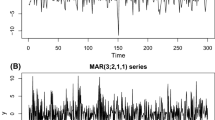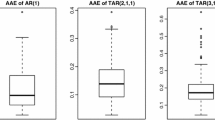Abstract
The smooth transition autoregressive (STAR)(k)–GARCH(l, m) model is a non-linear time series model that is able to account for changes in both regime and volatility respectively. The model can be widely applied to analyse the dynamic behaviour of data exhibiting these two phenomenons in areas such as finance, hydrology and climate change. The main aim of this paper is to perform a Bayesian analysis of STAR(k)–GARCH(l, m) models. The estimation procedure will include estimation of the mean and variance coefficient parameters, the parameters of the transition function, as well as the model orders (k, l, m). To achieve this aim, the joint posterior distribution of the model orders, coefficient and implicit parameters in the logistic STAR(k)–GARCH(l, m) model is presented. The conditional posterior distributions are then derived, followed by the design of a posterior simulator using a combination of MCMC algorithms which includes Metropolis–Hastings, Gibbs Sampler and Reversible Jump MCMC algorithms. Following this are extensive simulation studies and a case study presenting the methodology.
















Similar content being viewed by others
References
Ang A, Timmermann A (2012) Regime changes and financial markets. Annu Rev Financ Econ 4(1):313–337
Bollerslev T (1986) Generalized autoregressive conditional heteroskedasticity. J Econ 31(3):307–327
Box GEP, Jenkins GM (1976) Time series analysis: forecasting and control. Holden-Day Series in Time Series Analysis and Digital Processing. Holden-Day, Clarendon
Campbell EP (2004) Bayesian selection of threshold autoregressive models. J Time Ser Anal 25(4):467–482
Chan F, McAleer M (2002) Maximum likelihood estimation of STAR and STAR-GARCH models: theory and Monte Carlo evidence. J Appl Econ 17(5):509–534
Chan F, McAleer M (2003) Estimating Smooth Transition Autoregressive models with GARCH errors in the presence of extreme observations and outliers. Appl Financ Econ 13(8):581–592
Chan F, Theoharakis B (2011) Estimating m-regimes STAR-GARCH model using QMLE with parameter transformation. Math Comput Simul 81(7):1385–1396
Chan KS, Tong H (1986) On estimating thresholds in autoregressive models. J Time Ser Anal 7(3):179–190
Chen CWS, So MKP (2006) On a threshold heteroscedastic model. Int J Forecast 22(1):73–89
Chu L, McAleer M, Chen C (2012) How volatile is ENSO for global greenhouse gas emissions and the global economy? J Rev Glob Econ 1:1–12
Cowles MK, Carlin BP (1996) Markov chain Monte Carlo convergence diagnostics: a comparative review. J Am Stat Assoc 91(434):883–904
Deschamps PJ (2008) Comparing smooth transition and Markov switching autoregressive models of US unemployment. J Appl Econ 23(4):435–462
Engle R, Ng V (1993) Measuring and testing the impact of news on volatility. J Financ 48(5):1749–1778
Gerlach R, Chen CWS (2008) Bayesian inference and model comparison for asymmetric smooth transition heteroskedastic models. Stat Comput 18(4):391–408
Glosten Lawrence R, Jagannathan Ravi, Runkle David E (1993) On the relation between the expected value and the volatility of the nominal excess return on stocks. J Financ 48(5):1779–1801
Green PJ (1995) Reversible jump Markov chain Monte Carlo computation and Bayesian model determination. Biometrika 82(4):711–732
Hall AD, Skalin J, Teräsvirta T (2001) A nonlinear time series model of El Nino. Environ Model Softw 16(2):139–146
Hamilton JD (1989) A new approach to the economic analysis of nonstationary time series and the business cycle. Econometrica 57:357–384
Hastings WK (1970) Monte Carlo sampling methods using Markov chains and their applications. Biometrika 57(1):97–109
Jacquier E, Polson NG, Rossi PE (2002) Bayesian analysis of stochastic volatility models. J Bus Econ Stat 20(1):69–87
Li W, Lam K (1995) Modelling asymmetry in stock returns by a threshold autoregressive conditional heteroscedastic model. The Statistician 44:333–341
Liu S, Heyde CC (2008) On estimation in conditional heteroskedastic time series models under non-normal distributions. Stat Pap 49:455–469
Liu JS, Liang F, Wong WH (2000) The multiple-try method and local optimization in metropolis sampling. J Am Stat Assoc 95(449):121–134
Livingston Jr., G (2017) A Bayesian analysis of a regime switching volatility model. PhD thesis. School of Mathematical and Physical Sciences, The University of Newcastle, Australia
Livingston G Jr, Nur D (2017) Bayesian inference for smooth transition autoregressive (STAR) model: a prior sensitivity analysis. Commun Stat Simul Comput 46(7):5440–5461
Lopes HF, Salazar E (2006) Bayesian model uncertainty in smooth transition autoregressions. J Time Ser Anal 27(1):99–117
Lubrano M (2001) Smooth transition GARCH models: a Bayesian perspective. Recherches conomiques de Louvain/Louvain Econ Rev 67(3):257–287
Luukkonen R, Saikkonen P, Teräsvirta T (1988) Testing linearity against smooth transition autoregressive models. Biometrika 75(3):491–499
Metropolis N, Rosenbluth AW, Rosenbluth MN, Teller AH, Teller E (1953) Equation of state calculations by fast computing machines. J Chem Phys 21(6):1087–1092
Miazhynskaia T, Dorffner G (2006) A comparison of Bayesian model selection based on MCMC with an application to GARCH-type models. Stat Pap 47(4):525–549
Nelson Daniel B, Cao Charles Q (1992) Inequality constraints in the univariate GARCH model. J Bus Econ Stat 10(2):229–235
Nieto FH, Zhang H, Li W (2013) Using the reversible jump MCMC procedure for identifying and estimating univariate TAR models. Commun Stat Simul Comput 42(4):814–840
Nur D (1998) Parameter estimation of Smooth Threshold Autoregressive (1) models. PhD thesis. School of Mathematics and Statistics, Curtin University of Technology, Australia
Pandolfi S, Bartolucci F, Friel N (2010) A generalization of the multiple-try metropolis algorithm for Bayesian estimation and model selection. In: International conference on artificial intelligence and statistics, pp 581–588
R Development Core Team (2012) R: a language and environment for statistical computing. R Foundation for Statistical Computing, Vienna, Austria. ISBN 3-900051-07-0
Sentana E (1995) Quadratic ARCH models. Rev Econ Stud 62(4):639–661
Spiegelhalter DJ, Best NG, Carlin BP (2002) Bayesian measures of model complexity and fit. J R Stat Soc Ser B 64(4):583639
Teräsvirta T (1994) Specification, estimation, and evaluation of smooth transition autoregressive models. J Am Stat Assoc 89(425):208–218
Tong H (1978) On a threshold model. In: Chen CH (ed) Pattern recognition and signal processing. Sijthoff & Noordhoff, Amsterdam
Tong H (1983) Threshold models in non-linear time series analysis. Lecture Notes in Statistics, No. 21. Springer, New York
Tong H (1990) Non-linear time series: a dynamical system approach. Oxford Statistical Science Series 6. Oxford Science Publications, Oxford
Tong H (2015) Threshold models in time series analysis-some reflections. J Econom 189(2):485–491
Tong H, Lim KS (1980) Threshold autoregression, limit cycles and cyclical data. J R Stat Soc Ser B 42(3):245–292
Troughton PT, Godsill SJ (1997) A reversible jump sampler for autoregressive time series, employing full conditionals to achieve efficient model space moves. Technical report, University of Cambridge, Department of Engineering, Cambridge
Ubilava D, Helmers CG (2013) Forecasting ENSO with a smooth transition autoregressive model. Environ Model Softw 40:181–190
van Dijk D, Teräsvirta T, Franses PH (2002) Smooth transition autoregressive models a survey of recent developments. Econ Rev 21(1):1–47
Vermaak J, Andrieu C, Doucet A, Godsill SJ (2004) Reversible jump Markov Chain Monte Carlo strategies for Bayesian model selection in autoregressive processes. J Time Ser Anal 25(6):785–809
Vrontos ID, Dellaportas P, Politis DN (2000) Full Bayesian inference for GARCH and EGARCH models. J Bus Econ Stat 18(2):187–198
Wago H (2004) Bayesian estimation of smooth transition GARCH model using Gibbs sampling. Math Comput Simul 64:63–78
Acknowledgements
This paper arises from work in the PhD study of Dr Glen Livingston Jr who was funded by The Australian Postgraduate Award through the University of Newcastle, Australia.
Author information
Authors and Affiliations
Corresponding author
Rights and permissions
About this article
Cite this article
Livingston, G., Nur, D. Bayesian inference of smooth transition autoregressive (STAR)(k)–GARCH(l, m) models. Stat Papers 61, 2449–2482 (2020). https://doi.org/10.1007/s00362-018-1056-3
Received:
Revised:
Published:
Issue Date:
DOI: https://doi.org/10.1007/s00362-018-1056-3
Keywords
- Generalised ARCH (GARCH)
- Gibbs sampler algorithm
- Metropolis–Hastings algorithm
- Non-linear time series models
- Regime switching volatility
- Reversible jump MCMC algorithm




